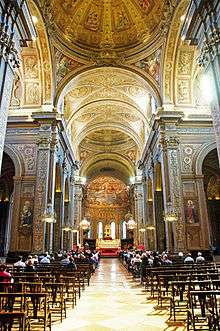Ferrara Cathedral
Ferrara Cathedral (Italian: Basilica Cattedrale di San Giorgio, Duomo di Ferrara) is a Roman Catholic cathedral and minor basilica in Ferrara, Northern Italy. Dedicated to Saint George, the patron saint of the city, it is the seat of the Archbishop of Ferrara and the largest religious building in the city.
| Ferrara Cathedral Cathedral of Saint George the Martyr Cattedrale di San Giorgio Martire (in Italian) | |
|---|---|
 Ferrara Cathedral west front | |
| Religion | |
| Affiliation | Roman Catholic |
| Province | Archdiocese of Ferrara-Comacchio |
| Rite | Roman |
| Year consecrated | 1135 |
| Location | |
| Location | Ferrara, Italy |
| Geographic coordinates | 44°50′7.83″N 11°37′12.52″E |
| Architecture | |
| Style | Romanesque, Gothic, Renaissance, Baroque |
| Groundbreaking | 12th century |
| Completed | 17th century |

The cathedral stands in the city centre, not far from the Palazzo Comunale and the famous Castello Estense and is connected to the Archbishop's Palace by a covered passage.
History
Construction of the present building began in the 12th century, when the city was being extended towards the left bank of the Po River; the new cathedral was consecrated in 1135. The former cathedral, also dedicated to Saint George, still stands on the right bank of the river outside the city walls and is now known as St George's Basilica Outside the Walls (San Giorgio fuori le mura).
Exterior
The original Romanesque design is manifest in the façade, which resembles those of Modena and Parma Cathedrals: it is in white marble, with three cusps and a series of loggias, small arcades and rose windows, statues and numerous bas-reliefs. On the right side is a statue of Alberto d'Este, while on the side is a bronze bust of Pope Clement VIII, over an inscription in memory of his capture of the city.
In the centre of the façade is a porch, supported by two columns with Atlases seated on lions at the bases. It is decorated with a Last Judgement by an unknown master and a loggia with a Madonna and Child (a late Gothic addition). The portal is the work of the sculptor Nicholaus, a pupil of Wiligelmus. The lunette shows Saint George, patron saint of Ferrara, slaying the dragon; scenes from the Life of Christ appear on the lintel. The jambs framing the entrance are embellished with figures depicting the Annunciation and the four prophets who foretold the coming of Christ.[1] According to a now-destroyed inscription, Nicholaus was responsible for the design of the original building. The two side portals on the west front are also his work, as is the lower loggia here and on the south side of the building. A second portal by Nicholaus with additions by Benedetto Antelami was present on the south side, but it was demolished during the 18th-century restorations. Some of the sculptures which decorated it are now on the piazza in front of the building (the supporting griffins), in the narthex and in the Cathedral Museum. The portal was used by pilgrims on their way to Rome. Also on the southern side is the unfinished Renaissance bell tower, in white and pink marble, attributed to Leon Battista Alberti and built in 1451-1493. The apse, in brickwork, has arches and marble capitals, and was designed by the Ferrarese architect Biagio Rossetti.
Interior
The interior, entirely remade in Baroque style after a fire in the 18th century, has a nave and two aisles. It houses bronze statues of the Crucifixion, by Niccolò Baroncelli, and of Saints George and Maurelius, by Domenico Alfani (15th century), as well as a Martyrdom of Saint Lawrence by Guercino (17th century). In the side chapels are a Madonna Enthroned with Saints by Il Garofalo, an Incoronation of the Virgin by Francesco Francia and a Virgin in Glory with Saints Barbara and Catherine by Bastianino, who also painted the Last Judgement in the apse choir (1577-1581).
Museum
The Cathedral Museum, housed in the former church of San Romano across the square, houses two works by Cosmè Tura (Annunciation and St. George and the Dragon), the Madonna della melagrana by Jacopo della Quercia and eight tapestries with stories of the two patron saints of Ferrara based on cartoons by Garofalo and Camillo Filippi.
Gallery
Burials
Bibliography
- Cittadella, Luigi Napoleone (1864). Notizie relative a Ferrara per la maggior parte inedite (in Italian). Ferrara: D. Taddei. pp. 42–115.
External links
| Wikimedia Commons has media related to Cathedral (Ferrara). |
- Page on medioevo.org (in Italian)






